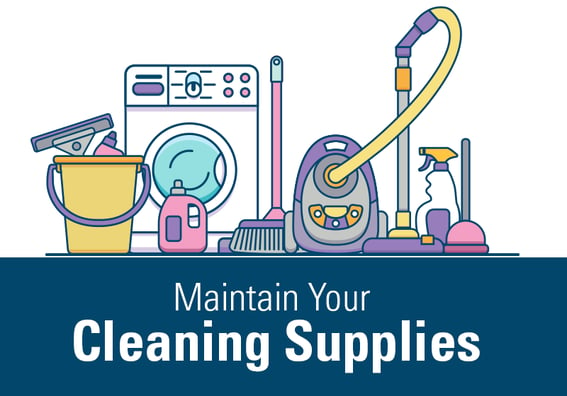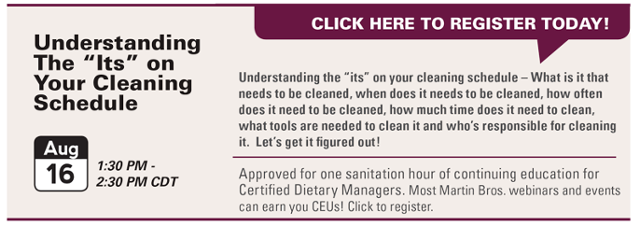
Your cleaning supplies need to be cleaned and maintained just like the rest of your facility. By taking proper care of your mops, brooms, vacuums, extractors and other tools, you will have better cleaning results and help prevent the need to replace your tools early, which will save you money.
VACUUMS
Doing easy routine maintenance can extend the life of your vacuum and help indoor air quality. Check bags and filters on a regular basis. Bags should be changed when they are half to 2/3 full. If the bag is full, it doesn’t allow enough airflow to the motor, which could cause it to overheat, and you could also lose a lot of suction power. Change the exhaust filter every five bags and the HEPA filter (if equipped with one) at least twice per year. If your vacuum is being used every day for a good portion of the day, you will probably have to change filters more frequently. Check the brush weekly for objects like string or hair that are wrapped around it. These things can be easily removed with a seam ripper. If you don’t remove them, they can cause broken belts or damage the motor. Also, clean the brush with disinfectant periodically, and when the brush gets to half its length, replace it. You should also disinfect the bottom plate, cover and other parts that collect dust. If you’ve lost suction power, check the hoses for clogs or the bags to see if they are too full.
TIP: Avoid vacuuming wet mats or liquids, because they can easily ruin your motor and cause mold and mildew issues inside the machine.
EXTRACTORS
After each use, unscrew the jets in the front of the machine and run vinegar and hot water through them to get rid of any hard water deposits that might restrict the flow of water. Drain and rinse the tanks to avoid bacteria and odor growth. Leave tank lids open as much as possible to dry them out. You could also add an odor counteractant or an enzyme-based cleaner/deodorizer to the tank to eliminate odors while not in use. Clean and rinse hoses, brushes and filters after each use. Do not allow brushes to rest on the floor when not in use, as this will flatten them out and cause uneven cleaning.
AUTO SCRUBBERS
If you are using wet acid batteries, check them often for proper water levels. Batteries are the most expensive replaceable component on scrubbers, and improper water levels will significantly decrease their life. Empty and rinse solution and recovery tanks after each use and allow them to dry with their lids open to avoid bacteria and odor growth. You could also add an odor counteractant or an enzyme-based cleaner/deodorizer to tanks to eliminate odors while not in use. Clean and inspect brushes, pad driver and squeegees after each use. Always keep squeegees and brushes off the floor when the machine is not in use to avoid damaging them.
MOP BUCKETS
Always rinse thoroughly after each use with an appropriate cleaner. Then, either wipe dry or turn upside down to dry completely before storing. If you are in a healthcare environment, you may want to disinfect the inside of the mop bucket after rinsing and drying and then allow to air dry. This will help avoid unwanted bacterial growth in your bucket. Periodically check casters for wear. Most manufacturers have replacement casters you can purchase without having to buy a whole new bucket.
TIP: When using floor finish in your bucket, line the bucket with a trash can liner and then pour in the finish. This makes for easy cleanup and keeps buckets free from finish buildup.
MOP HEADS
After use, all mop heads should be rinsed with warm water and hung to dry in a well-ventilated area. This will help them stay odor free. If your mop head does develop an odor, it means there is bacteria growing in it; you should either replace it or try soaking it in a quat disinfectant for 10 minutes and then allow it to dry. Do not leave mop heads on the handle to dry, as this can lead to mold growth, and never leave a mop in a wet solution overnight. If your mop heads are launderable, launder them…but avoid using fabric softener. Fabric softener creates a film on the mop strands, which prevents the absorption of liquids and can cause streaking on floors.
TIP: Strong cleaning solutions such as bleach and other caustic cleaners will break down mop strands more quickly than other cleaners, so choose cleaners wisely.
DUST MOPS
At the end of each shift, either vacuum, brush or shake out dust mops completely. Be sure to store them with their heads up, not touching the wall or floor. If your dust mop is launderable, do so when soiled. Some manufacturers recommend laundering in a mesh laundry bag. Do not use fabric softener, or it will create a film that will prevent good dusting.
BROOMS/BRUSHES
Always store brooms and brushes off the ground. Do not leave them sitting on their bristles, because they will bend and split and then not clean as effectively. Collect dust and debris off the bristles after each use, combing the bristles to remove large debris. You should remove dust weekly by banging the broom outside on a wall or on the pavement. If you use your brooms and brushes frequently, you may need to do this more often. Assuming your broom or brush can get wet, you should occasionally run it under warm water and use a mild detergent to thoroughly clean the bristles. Then, hang it on the wall and allow to air dry.







